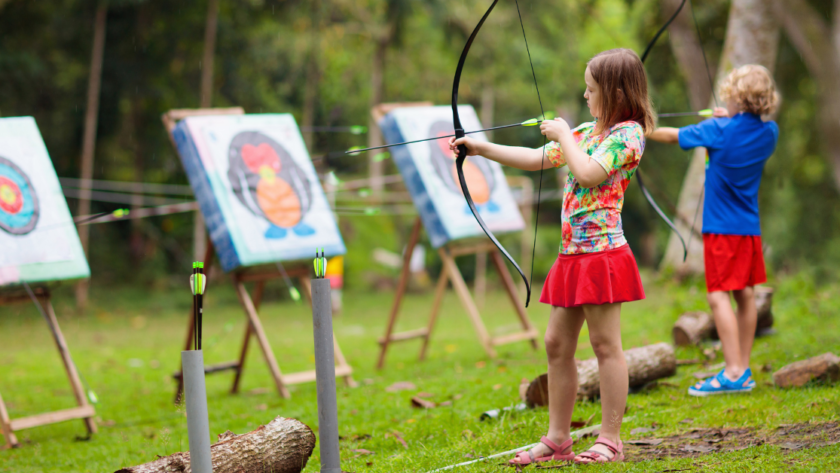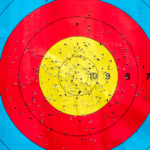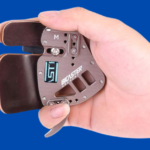As an archer with years of experience, I’ve developed a deep appreciation for the rich language that defines our sport.
Understanding archery terminology enhances your ability to talk effectively with fellow archers, improve your technique, and deepen your appreciation for this ancient art.
The Anatomy of a Bow
The Riser
The riser is the central part of the bow that you grip. It serves as the foundation, connecting all other components.
Modern risers are typically made from aluminum or carbon fiber, offering a balance of strength and lightweight performance.
The riser houses important features such as the arrow rest, sight mount, and stabilizer bushings.
Limbs
Attached to the riser are the limbs – the flexible upper and lower portions that store energy when the bow is drawn.
Limb materials vary, with high-end bows often using carbon fiber or composite materials for optimal performance.
The limb’s design significantly impacts the bow’s draw weight, speed, and overall feel.
Bowstring
Stretched between the limb tips, the bowstring is where the magic happens. Modern strings are typically made from materials like Dacron, FastFlight, or other high-performance fibers.
The string’s material and construction affect the bow’s performance, including arrow speed and shot noise.
Types of Bows and Their Unique Terminology
Recurve Bows
Recurve bows, with their distinctive curved limbs, are the Olympic standard. They offer a blend of traditional form and modern performance.
Key terms for recurve bows include:
- Tiller: The difference in distance between the string and the upper and lower limbs.
- Nocking Point: The point on the string where the arrow is nocked.
- Plunger Button: An adjustable device that helps tune arrow flight.
Compound Bows
Compound bows employ a system of cables and pulleys, introducing a whole new set of terms:
- Let-off: The reduction in holding weight at full draw, typically expressed as a percentage.
- Cam: The wheel-like mechanism at the end of the limbs that provides mechanical advantage.
- Draw Length: The distance from the nocking point to the pivot point of the grip plus 1.75 inches.
- Valley: The point in the draw cycle where the bow reaches maximum let-off.
Longbows
For those who prefer a touch of history, longbows bring their own set of terms rooted in centuries of tradition:
- Self Bow: A bow made from a single piece of wood.
- Backed Bow: A bow with a layer of material (often sinew or rawhide) glued to the back for added strength.
- Belly: The side of the bow facing the archer when shooting.
Arrow Anatomy
An arrow is a finely tuned instrument of flight. Understanding it’s components is crucial for any archer:
Shaft
The arrow’s backbone, typically made of wood, aluminum, or carbon fiber. The shaft’s material affects it’s weight, spine (stiffness), and durability.
Arrowhead or Point
Attached to the front of the shaft, the point’s design varies based on the arrow’s intended use (target practice, hunting, etc.).
Nock
Located at the rear of the arrow, the nock clips onto the bowstring. It’s usually made of plastic and comes in various sizes to match different string thicknesses.
Fletching
Near the nock, you’ll find the fletching – feathers or plastic vanes that stabilize the arrow’s flight. The number, size, and configuration of fletches can significantly impact arrow performance.
Arrow Spine
Understanding arrow spine – the stiffness of the shaft – is crucial for achieving accurate shots. It’s a delicate balance between the arrow’s flexibility and the bow’s power.
Proper spine selection confirms the arrow flexes correctly around the bow during release, a phenomenon known as the “archer’s paradox.”
The Art of the Shot
Archery technique is where terminology truly comes alive. Mastering these concepts is essential for consistent, accurate shooting:
Anchor Point
The anchor point is the consistent position where your drawing hand meets your face at full draw. Common anchor points include the corner of the mouth or under the chin. A consistent anchor point is basic to repeatable accuracy.
Release
The release is the moment when you let the string slip from your fingers or release aid. A clean, smooth release minimizes string interference with the arrow’s flight.
Different release techniques include:
- Mediterranean Release: Using three fingers under the nock.
- Mongolian Release: Using the thumb, often with a thumb ring.
- Mechanical Release: Using a handheld or wrist-strap device to release the string.
Aiming Methods
Archers use various aiming methods, each with it’s own terminology:
- Gap Shooting: Estimating the distance between the arrow point and the target.
- Instinctive Shooting: Aiming subconsciously without a specific reference point.
- String Walking: Adjusting finger placement on the string for different distances.
These techniques allow archers to adjust their aim for different distances without relying on sights, showcasing the sport’s blend of instinct and calculation.
Enhancing Performance
Modern archery has embraced technology to push the boundaries of human performance:
Sights
Sights help archers aim with incredible precision. Types of sights include:
- Pin Sights: Multiple pins set for different distances.
- Movable Sights: A single pin that can be adjusted for various ranges.
- Scope Sights: Magnified sights often used in target archery.
Stabilizers
Stabilizers reduce bow movement for steadier shots. They come in various lengths and configurations:
- Front Stabilizer: Extends forward from the bow.
- Side Rods: Extend to the sides for extra balance.
- V-Bar: A V-shaped attachment that holds side rods.
Release Aids
Primarily used by compound archers, release aids offer a mechanical advantage for a smoother, more consistent release. Types include:
- Index Finger Release: Triggered by the index finger.
- Thumb Release: Activated by the thumb.
- Back Tension Release: Triggered by rotating the release body.
Back Tension
Back tension describes a technique that relies on the archer’s body mechanics to achieve a clean release. It involves gradually increasing tension in the back muscles until the release occurs, promoting a surprise release that minimizes target panic.
Overcoming Challenges
Every archer faces obstacles, and our terminology reflects this:
Target Panic
Target panic is a psychological hurdle that many archers encounter, where the fear of missing the target interferes with the shot process. Symptoms can include:
- Inability to hold steady on the target
- Premature release of the arrow
- Freezing up and inability to release
Overcoming target panic often involves retraining mental processes and shot execution.
Archer’s Paradox
Archer’s paradox is the phenomenon where an arrow must bend around the bow to fly straight. This concept is crucial for understanding proper arrow spine selection and bow tuning.
Factors affecting archer’s paradox include:
- Arrow spine
- Draw weight
- Point weight
- Release technique
Mastering this concept is essential for achieving optimal arrow flight and accuracy.
Adapting to Different Disciplines
Archery isn’t a one-size-fits-all sport, and our terminology reflects the diversity of disciplines:
Field Archery
Field archery introduces terms related to shooting in varied terrain and conditions:
- Unmarked Distances: Courses where archers must estimate target distances.
- Walk-up: A target where archers shoot from multiple distances.
- Fan: A set of targets arranged in a fan shape.
3D Archery
3D archery, with it’s lifelike animal targets, brings a whole new vocabulary:
- IBO Speed: Arrow speed measured according to International Bowhunting Organization standards.
- Vitals: The scoring area on a 3D target representing an animal’s vital organs.
- Range Finding: The process of estimating target distance without mechanical aids.
Bowhunting
For those who venture into bowhunting, extra terms become essential:
- Broadheads: Hunting arrowheads designed for maximum penetration and tissue damage.
- Let-down: The act of carefully un-drawing a bow without releasing an arrow.
- Ethical Shot Placement: Aiming for specific areas to confirm quick, humane kills.
From Basics to Mastery
As you progress in archery, you’ll find that understanding terminology is key to advancing your skills:
Follow-through
Follow-through describes maintaining your shooting form after the arrow has left the bow. A proper follow-through confirms consistency and can reveal flaws in technique.
Expansion
Expansion refers to the feeling of continuous drawing motion, even at full draw. This concept helps maintain back tension and promotes a clean release.
Bow Tuning
Mastery in archery often involves delving into the minutiae of equipment setup. Key tuning terms include:
- Tiller: The difference in distance between the string and the upper and lower limbs.
- Brace Height: The distance between the deepest part of the grip and the string when the bow is at rest.
- Nocking Point Height: The position of the nocking point on the string relative to level.
Understanding these terms allows archers to fine-tune their equipment for optimal performance.
Practical Application
To truly internalize archery terminology, practice is key. Here’s an exercise to get you started:
- Set up your bow and go through each component, naming it and describing it’s function.
- As you shoot, narrate your process using proper terminology.
- After each shot, analyze your form and execution using the terms you’ve learned.
This process reinforces your knowledge and helps you focus on each aspect of your shot.
For a more advanced exercise, try explaining a complex concept like archer’s paradox to a fellow archer. The act of teaching often solidifies our own understanding and highlights areas where we might need to deepen our knowledge.
Frequently Asked Questions
What is the difference between a recurve and compound bow?
A recurve bow has curved limbs and a single string, while a compound bow uses a system of cables and pulleys to provide mechanical advantage.
How do I choose the right draw weight for my bow?
Selecting the suitable draw weight depends on your physical strength, intended use (target shooting or hunting), and experience level. It’s best to start with a lower weight and work your way up.
What is the purpose of fletching on an arrow?
Fletching stabilizes the arrow’s flight by creating drag at the rear of the shaft, ensuring the arrow flies straight and true.
How often should I replace my bowstring?
The frequency of bowstring replacement depends on usage and care. Generally, it’s recommended to replace the string every 1-2 years or sooner if you notice fraying or excessive wear.
What is the proper way to store a bow?
Store your bow in a cool, dry place, preferably in a bow case. For compound bows, it’s safe to leave them strung.
Recurve and longbows should be unstrung when not in use for extended periods.
How do I determine my fix draw length?
To estimate your draw length, measure your arm span from fingertip to fingertip, then divide by 2.5. For a more accurate measurement, visit an archery pro shop for a professional fitting.
What is the difference between field points and broadheads?
Field points are used for target practice and have a simple, bullet-shaped design. Broadheads are used for hunting and have sharp blades designed to cause maximum damage to game animals.
How can I improve my accuracy in archery?
Improving accuracy involves consistent practice, proper form, and equipment tuning. Focus on developing a repeatable shot process and seek feedback from experienced archers or coaches.
What is the purpose of a stabilizer on a bow?
Stabilizers help reduce bow movement during and after the shot by adding weight and dampening vibrations. This can lead to improved accuracy and a more comfortable shooting experience.
How do I know if my arrows are properly spined for my bow?
Proper arrow spine depends on your bow’s draw weight, draw length, and arrow length. Consult an arrow spine chart or visit an archery pro shop for assistance in selecting the fix spine.
Key Takeaways
- Archery terminology is essential for effective communication and skill development.
- Understanding the language of different bow types enhances your versatility as an archer.
- Arrow anatomy and selection are crucial for achieving optimal performance.
- Mastering technique-related terms is key to refining your shot process.
- Familiarity with equipment terminology allows for better customization and tuning.
- Different archery disciplines each bring their own set of terms to learn.
- Regular practice and application of terminology enhances overall archery knowledge and skill.



